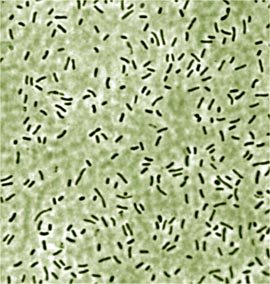Chlorobium species strain BS1, Black Sea strain Chlorobium sp. strain BS1 is a green sulfur bacterium cultivated from the chemocline of the Black Sea. Cells are rod-shaped, immotile and brown-colored. This bacterium forms an extremely dilute, but detectable population in the Black Sea at a depth of about 100 m (1). Based on the analysis of the 16S rRNA gene sequences, a single phylotype of green sulfur bacteria is present in the natural bacterial community. Comparison of its 16S rRNA gene sequence with all known sequences in the databases revealed that the Black Sea bacterium is unique and has not yet been discovered in any other ecosystem. According to recent measurements, light intensities in the Black Sea chemocline reach 0.001 µmol photons m-2s-1 during winter, corresponding to 0.0007% of surface light intensity. Experiments with laboratory cultures revealed that the green sulfur bacterium from the Black Sea chemocline is extraordinarily low-light adapted, and in its natural environment probably grows with doubling times of several years (2). Under severely limiting light intensities of <= 1 µmol Quanta·m-2s-1 , the Black Sea isolates grew significantly faster than related green sulfur bacteria. As demonstrated by ultrathin sectioning and electron microscopy, the cells produce chlorosomes that are two-fold larger than those of another Chlorobium phaeobacteroides strain (DSMZ 266 T ) (3). Each bacteriochlorophyll e molecule present would absorb on average one photon every 8 hours at the light intensities present in the Black Sea chemocline. The ecological situation of phototrophic organisms in the Black Sea chemocline is comparable to that of plants grown at a distance of 50 m from a little candle in an otherwise pitch black glass house. The evidence accumulated to date indicates that the particular green sulfur bacterium dwelling in the Black Sea chemocline is indeed capable of exploiting this minute light intensity. Strain BS 1 represents an excellent model system not only for the study of low-light adaptation but also for the study of molecular mechanisms of the adaptation towards extreme energy-limitation. Derivatives of the specific bacteriochlorophylls and carotenoids of the obligately anoxygenic phototrophic green sulfur bacteria have been detected from late Ordovician marine black shales through Messinian Marl sediments (4). These findings have sparked a considerable interest in the structure and function of such large oceanic oxic/anoxic environments. The Black Sea is the largest extant anoxic water body on the planet and represents the closest contemporary analogue to past sulfidic oceans. Therefore, the green sulfur bacterium from the chemocline of the Black Sea is significant also with respect to paleoceanography, since it may serve as an indicator for the reconstruction of past photic zone anoxia (1). To this end, a detailed reconstruction of environmental conditions in ancient oceans require a better knowledge of the physiology of this unusual bacterium. References(1) Overmann, J., Manske, A.K. (2005) Anoxygenic phototrophic bacteria in the Black Sea. Chapter II d.1. In: Neretin, L. (ed.) Past and Present water column anoxia . NATO ASI series. Springer-Verlag, Berlin. (2) Overmann J., Cypionka H., Pfennig N. (1992) An extremely low-light-adapted phototrophic sulfur bacterium from the Black Sea. Limnol. Oceanogr. 37 , 150-155 (3) Fuhrmann S., Overmann J., Pfennig N., Fischer U. (1993) Influence of vitamin B 12 and light on the formation of chlorosomes in green- and brown-colored Chlorobium species. Arch. Microbiol. 160 , 193-198 (4) Hartgers, W.A., Sinninghe Damsté, J.S., Requejo, A.G., Allan, J., Hayes, J.M., de Leeuw, J.W. (1994) Evidence for only minor contributions from bacteria to sedimentary organic carbon. Nature 369 : 224-227 |
||
|
||
Chlorobium phaeobacteroides BS1

